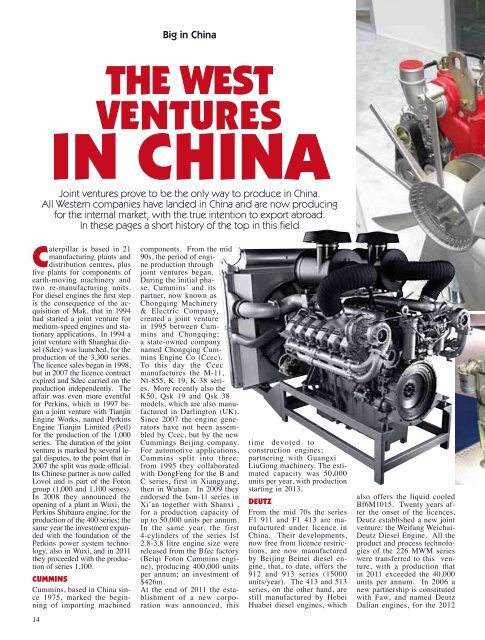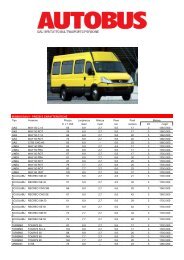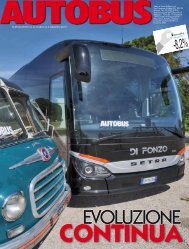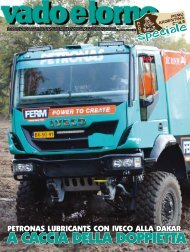Doosan - Vado e Torno Edizioni
Doosan - Vado e Torno Edizioni
Doosan - Vado e Torno Edizioni
You also want an ePaper? Increase the reach of your titles
YUMPU automatically turns print PDFs into web optimized ePapers that Google loves.
Big in China<br />
THE WEST<br />
VENTURES<br />
IN CHINA<br />
Joint ventures prove to be the only way to produce in China.<br />
All Western companies have landed in China and are now producing<br />
for the internal market, with the true intention to export abroad.<br />
In these pages a short history of the top in this fi eld<br />
Caterpillar is based in 21<br />
manufacturing plants and<br />
distribution centres, plus<br />
five plants for components of<br />
earth-moving machinery and<br />
two re-manufacturing units.<br />
For diesel engines the first step<br />
is the consequence of the acquisition<br />
of Mak, that in 1994<br />
had started a joint venture for<br />
medium-speed engines and stationary<br />
applications. In 1994 a<br />
joint venture with Shanghai diesel<br />
(Sdec) was launched, for the<br />
production of the 3,300 series.<br />
The licence sales began in 1998,<br />
but in 2007 the licence contract<br />
expired and Sdec carried on the<br />
production independently. The<br />
affair was even more eventful<br />
for Perkins, which in 1997 began<br />
a joint venture with Tianjin<br />
Engine Works, named Perkins<br />
Engine Tianjin Limited (Petl)<br />
for the production of the 1,000<br />
series. The duration of the joint<br />
venture is marked by several legal<br />
disputes, to the point that in<br />
2007 the split was made official.<br />
Its Chinese partner is now called<br />
Lovol and is part of the Foton<br />
group (1,000 and 1,100 series).<br />
In 2008 they announced the<br />
opening of a plant in Wuxi, the<br />
Perkins Shibaura engine, for the<br />
production of the 400 series; the<br />
same year the investment expanded<br />
with the foundation of the<br />
Perkins power system technology,<br />
also in Wuxi, and in 2011<br />
they proceeded with the production<br />
of series 1,100.<br />
CUMMINS<br />
Cummins, based in China since<br />
1975, marked the beginning<br />
of importing machined<br />
components. From the mid<br />
90s, the period of engine<br />
production through<br />
joint ventures began.<br />
During the initial phase,<br />
Cummins’ and its<br />
partner, now known as<br />
Chongqing Machinery<br />
& Electric Company,<br />
created a joint venture<br />
in 1995 between Cummins<br />
and Chongqing;<br />
a state-owned company<br />
named Chongqing Cummins<br />
Engine Co (Ccec).<br />
To this day the Ccec<br />
manufactures the M-11,<br />
Nt-855, K 19, K 38 series.<br />
More recently also the<br />
K50, Qsk 19 and Qsk 38<br />
models, which are also manufactured<br />
in Darlington (UK).<br />
Since 2007 the engine generators<br />
have not been assembled<br />
by Ccec, but by the new<br />
Cummings Beijing company.<br />
For automotive applications,<br />
Cummins split into three:<br />
from 1995 they collaborated<br />
with DongFeng for the B and<br />
C series, first in Xiangyang,<br />
then in Wuhan. In 2009 they<br />
endorsed the Ism-11 series in<br />
Xi’an together with Shanxi ,<br />
for a production capacity of<br />
up to 50,000 units per annum.<br />
In the same year, the first<br />
4-cylinders of the series Isf<br />
2.8-3.8 litre engine size were<br />
released from the Bfec factory<br />
(Beiqi Foton Cummins engine),<br />
producing 400,000 units<br />
per annum; an investment of<br />
$426m.<br />
At the end of 2011 the establishment<br />
of a new corporation<br />
was announced, this<br />
time devoted to<br />
construction engines;<br />
partnering with Guangxi<br />
LiuGong machinery. The estimated<br />
capacity was 50,000<br />
units per year, with production<br />
starting in 2013.<br />
DEUTZ<br />
From the mid 70s the series<br />
F1 911 and F1 413 are manufactured<br />
under licence in<br />
China. Their developments,<br />
now free from licence restrictions,<br />
are now manufactured<br />
by Beijing Beinei diesel engine,<br />
that, to date, offers the<br />
912 and 913 series (15000<br />
units/year). The 413 and 513<br />
series, on the other hand, are<br />
still manufactured by Hebei<br />
Huabei diesel engines, which<br />
also offers the liquid cooled<br />
Bf6M1015. Twenty years after<br />
the onset of the licences,<br />
Deutz established a new joint<br />
venture: the Weifang Weichai-<br />
Deutz Diesel Engine. All the<br />
product and process technologies<br />
of the 226 MWM series<br />
were transferred to this venture,<br />
with a production that<br />
in 2011 exceeded the 40,000<br />
units per annum. In 2006 a<br />
new partnership is constituted<br />
with Faw, and named Deutz<br />
Dalian engines, for the 2012<br />
and 1013 series for vehicular<br />
use. The first products were<br />
released in 2009 and today<br />
the official production capacity<br />
is 200,000 units per year.<br />
In 2011 a new joint venture<br />
was announced, still devoted<br />
to the 2011 series, but for offroad.<br />
They partnered with the<br />
Shandong Changlin machinery<br />
group, with an estimated<br />
capacity of 65,000 units and<br />
production scheduled to start<br />
in 2013. The latest news speculates<br />
a third agreement with<br />
In China<br />
the<br />
Offroad<br />
legislation<br />
is still stuck<br />
on Tier 2. This is<br />
the only reason<br />
for the lack<br />
of heavy duty<br />
engines in<br />
European and US<br />
markets.<br />
Shandong Changlin, for the<br />
production of the Tier2-<br />
and Tier3-homologated<br />
2011 units in Linyl, to be<br />
exported to markets compatible<br />
with these steps.<br />
FPT INDUSTRIAL<br />
In 1984, supported by the<br />
Ministry of Machine Manufacturing,<br />
two agreements<br />
for the licensed production<br />
of farming tractors were established<br />
between Cnh and Saic<br />
(Shanghai auto industry co.), the<br />
first resulting in the Shanghai<br />
New Holland, the second with<br />
a company in Luoyang (which<br />
is no longer in existence).<br />
Meanwhile, Naveco was created<br />
in 1996 from the equal<br />
agreement with Nanjin automobile<br />
works, to introduce the<br />
Daily light vehicles and for the<br />
production of the Sofim 8140<br />
engine in Euro II. In 2007,<br />
Nanjing auto merged with<br />
Saic, and that is how, in 2007,<br />
the joint venture Saic Iveco<br />
Hongyang was founded, with<br />
the intent of manufacturing the<br />
Nef and Cursor series engines<br />
(200,000 units/year). The expected<br />
foreign investment was<br />
150 million euros. The production<br />
was set in ChongQing,<br />
with the first engine released in<br />
2009 and in 2011 the production<br />
was estimated at 20,000<br />
units. The collaboration scene<br />
was completed with Hadong<br />
Teksid, the major Chinese engine<br />
block manufacturer, and<br />
with Shanghai Meridian, that<br />
produces magnesium castings.<br />
The presence of Fiat reflected<br />
the break line between the two<br />
phases in the group’s history,<br />
and the final stage appeared<br />
to be pointing to a substantial<br />
symbiosis between Fiat and<br />
its very powerful local partner,<br />
Siac.<br />
JOHN DEERE<br />
The first joint venture, established<br />
with Good Union with the<br />
intention of producing combine<br />
harvesters, dates back to 1997.<br />
In 2000, a new joint venture<br />
with Tianjin tractor works followed,<br />
the John Deere Tiantuo,<br />
for the production of mediumpowered<br />
tractors, over 60 kW.<br />
A new agreement was signed<br />
with Ningbo Benye Tractors in<br />
2007, for the production of ultra-compact<br />
small tractors, ranging<br />
between 15 and 37 kW. In<br />
2008 it is Xzhou Bohui’s turn,<br />
this time for building sites, for<br />
the production of excavators.<br />
However recently, no more<br />
than two years ago, the way of<br />
investing has changed: Cervo<br />
bypasses co-owned firms to focus<br />
on direct investments.<br />
The first outcome of this strategy<br />
shift came to shape at the<br />
production site in Harbin, devised<br />
for the development of harvesting<br />
machinery, while in the<br />
Teda area (Tianjin economic<br />
development area) a second<br />
unit of earth-moving machinery<br />
production was established.<br />
The same area will hold the<br />
production of engines that was<br />
announced in 2011 and will set<br />
forward in 2013, with an expected<br />
investment of $60m. This<br />
will therefore be the sixth engine<br />
production unit of the group<br />
and the seventh Cervo plan in<br />
the middle ground.<br />
MAN<br />
According to the Nuremberg<br />
firm, the brightest star in<br />
the Chinese sky is Weichai,<br />
the key motoring partner for<br />
diesel engines designed for<br />
stationary applications, that<br />
has nevertheless also been<br />
involved in the production<br />
of engines for vehicular use,<br />
which at the moment are still<br />
not in planning phase. Weichai,<br />
only ten years old, was<br />
founded after the merging of<br />
numerous firms, among which<br />
the Weichai factory, founded<br />
in 1953, that in the 80s had<br />
established a partnership with<br />
Steyr, resulting in the production<br />
of the Wd615.<br />
60% of the earnings come from<br />
heavy vehicles, thus justifying<br />
the partnership with Man, while<br />
30% is assimilated by construction<br />
and the remaining 10% by<br />
marine production.<br />
VOLVO<br />
Volvo Penta was the first business<br />
unit to face the Chinese<br />
market. In 2000, in fact, a<br />
new plant for the assembly of<br />
engines and power generators<br />
was inaugurated in Wuxi. The<br />
partner is Wuxi diesel engine<br />
works. For the earth-moving<br />
sector a joint venture with<br />
Shandong Lingong construction<br />
machinery co. was established<br />
(Lingong), intended for the<br />
production of tyred excavators.<br />
Another unit, entirely under the<br />
control of Volvo construction<br />
equipment, collaborated with it<br />
in Shangai for the production<br />
of compact and caterpillar excavators.<br />
In 2003, Volvo initiated<br />
a joint venture with Cnhtc<br />
(China National Heavy Transport<br />
co.), but in 2009, the poor<br />
success of the operation led to<br />
the termination of the venture<br />
and so was entirely taken over<br />
by Cnhtc. In January, Volvo<br />
signed an agreement with the<br />
Chinese vehicle manufacturer,<br />
Dongfeng Motor Group Company<br />
Limited (DFG), to acquire<br />
45% of a new subsidiary of<br />
DFG, Dongfeng Commercial<br />
Vehicles (DFCV), which will<br />
include a major part of DFG’s<br />
medium and heavy-duty commercial<br />
vehicles business. Upon<br />
completion of the contract, the<br />
Volvo Group will become the<br />
world’s largest manufacturer of<br />
heavy-duty trucks. A collaboration,<br />
which is no novelty, but is<br />
strengthened by almost twenty<br />
years of work with Nissan diesel,<br />
which today is part of the<br />
Swedish group.<br />
SCANIA<br />
The Swedish firm has established<br />
itself in primis commercially,<br />
focusing on the bus<br />
sector, consenting in 2007 to a<br />
joint venture with Jiangsu Alfa<br />
bus for production. As far as<br />
lorries are concerned, the focus<br />
shifted to Brasil and India, while<br />
for diesel engines an agreement<br />
for the distribution was signed<br />
with Shanghai Boden Engine<br />
Co. The agreement mainly addressed<br />
stationary purposes, in<br />
particular, power generators, as<br />
well as post-sale support.<br />
Catherine Morrison<br />
14 15






